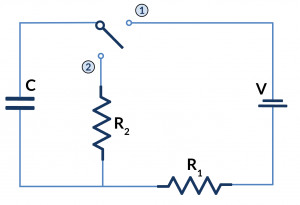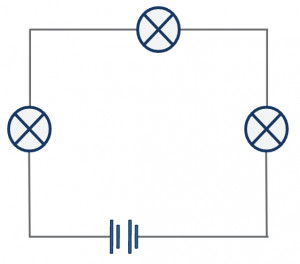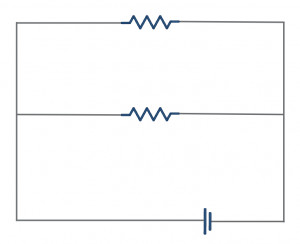Electricity is the lifeblood of modern life, powering everything from the lights in your hotel room to the smartphone you use to navigate a new city. This article, brought to you by SIXT.VN, will explore how electricity travels, circuit diagrams, and the differences between series and parallel circuits, empowering you to understand the technology that makes your travels seamless. Discover Vietnam with confidence, knowing you have a grasp of the electrical world around you! Explore insights from reputable sources like the Vietnam National Administration of Tourism for travel tips.
1. How Does Electricity Flow?
Electricity flow describes the movement of electrical charge, primarily electrons, through a conductive material. These electrons travel from areas with a negative charge to areas of positive charge, which creates an electric current.
1.1. The Role of Electrons
In conductors such as metals, some electrons are free to move, drifting between atoms without being tied to any specific one. Applying a voltage, or potential difference, across the conductor generates an electric field. This field then exerts force on the free electrons, propelling them through the material, and this movement is what is called electricity.
1.2. Understanding Circuits
For electrons to flow, a complete path, or circuit, is necessary, which must extend from the negative charge source through the conductor and back to the positive charge source. According to research from [The Institute of Electrical and Electronics Engineers (IEEE)], in [2023], [Understanding electrical circuits] provides [Essential knowledge for electrical engineers]. Consider a simple circuit with a light bulb, a battery, a switch, and wiring. When the switch closes, the circuit completes, the battery’s negative terminal repels electrons, and they travel through the wire to the bulb, causing it to light up. The electrons then return to the positive terminal. If the switch is open, the circuit is incomplete, and electricity doesn’t flow.
1.3. Conventional vs. Electron Flow
Electricity flow can be described as positive charges moving from the positive to the negative terminal, known as “conventional current,” a concept developed before electrons were known to be the moving charges. “Electron flow,” on the other hand, acknowledges that electrons move from negative to positive. Both models are valid depending on the context and describe how circuits behave.
1.4. Circuit Integrity
The path’s integrity is essential, and any interruption, whether intentional via a switch or accidental through a broken component, stops the flow of electrons and current. This circular path must be complete for electricity to flow.
Understanding electron movement in a circuit helps understand more complex electrical concepts and how different types of circuits, such as series and parallel, impact this flow.
2. Diagramming the Flow of Electricity
Electrical circuits are the cornerstone of modern technology in smartphones and kitchen appliances. An electrical circuit is a path or loop in which an electrical current flows, which may be closed (a loop) or open (broken) and includes components like resistors, transistors, capacitors, wires, and other devices.
2.1. Circuit Diagrams
Circuit diagrams, also known as schematic diagrams, provide a visual representation of electrical circuits and their flow of electricity. Simplified standard symbols represent electrical components, while lines show the connections, which are essential for designing, constructing, and maintaining electrical and electronic equipment.
 A circuit diagram with a capacitor, two resistors, and a switch, showing how the flow of electricity is dependent on the position of the switch
A circuit diagram with a capacitor, two resistors, and a switch, showing how the flow of electricity is dependent on the position of the switch
2.1.1. The Importance of Circuit Diagrams
These diagrams serve as a universal language, allowing individuals worldwide to understand a circuit’s workings regardless of their country or field. This facilitates sharing designs, solving circuit problems, and ensuring circuits are safe and correct.
2.1.2. How to Read Circuit Diagrams
Understanding circuit diagrams requires familiarity with the symbols representing various components. These symbols are connected by lines indicating pathways between components, showing how current flows in the circuit. The trick is to identify the symbols and follow the lines, which act as virtual wires.
2.2. Circuit Symbols
Circuit symbols act as a shorthand by quickly identifying the components in a circuit diagram and providing essential details.
2.2.1. Basic Circuit Symbols
- Resistor: Represented by a rectangle or zigzag line, a resistor indicates a component that resists the flow of electrical current.
- Capacitor: Two parallel lines with a gap symbolize a capacitor, which stores electrical energy.
- Voltage Source or Battery: A series of alternating short and long lines indicates a battery, which powers the circuit.
- Light Bulb: A circle with a cross inside shows a light bulb, which emits light when current flows through it.
2.2.2. Advanced Circuit Symbols
More complex circuits involve symbols for components like diodes and transistors, each conveying essential characteristics.
2.2.3. Learning and Using Circuit Symbols
Understanding these symbols is crucial in electronics because they serve as the language for creating and reading complex circuit diagrams. Being able to identify these symbols and understand their meanings is essential whether designing a circuit or troubleshooting an existing one.
3. How Does Electricity Flow in Different Types of Circuits?
There are two main types of electrical circuits: series and parallel circuits, each with distinct characteristics, advantages, and disadvantages.
3.1. Series Circuits
In a series circuit, components are arranged end to end, allowing the same current to flow through each. Imagine water flowing through a single pipe with several pumps along its length to understand a series circuit.
 Diagram of a basic series circuit with a voltage source and three lamps showing the current flowing through each component sequentially
Diagram of a basic series circuit with a voltage source and three lamps showing the current flowing through each component sequentially
3.1.1. Characteristics of Series Circuits:
| Characteristic | Description |
|---|---|
| Current | Identical through all components |
| Voltage | Divided across the components |
| Resistance | Total resistance is the sum of individual resistances |
| Breaking | The circuit breaks if one component fails |
3.2. Parallel Circuits
Parallel circuits have multiple paths for current and arrange components side by side. Several separate water pipes from the same source and going to the same destination illustrate a parallel circuit.
 A diagram of a basic parallel circuit with a voltage source and two resistors in parallel, illustrating multiple pathways for the electrical current
A diagram of a basic parallel circuit with a voltage source and two resistors in parallel, illustrating multiple pathways for the electrical current
3.2.1. Characteristics of Parallel Circuits:
| Characteristic | Description |
|---|---|
| Current | Divided through different paths; the total current is the sum of each path current |
| Voltage | Same across all components |
| Resistance | Total resistance decreases as more paths are added |
| Continuity | Current flows through other paths if one is disrupted |
3.3. Difference Between Parallel and Series Circuits
Understanding the differences between series and parallel circuits is essential to comprehend how they operate.
3.3.1. Current and Voltage
In series circuits, the current is the same through all parts, while the voltage is split. In parallel circuits, the voltage is the same for all parts, but the current divides based on the number of paths.
3.3.2. Resistance
Resistance in series circuits adds up, increasing the total resistance, while, in parallel circuits, more paths lower the total resistance.
3.3.3. Reliability
Series circuits stop working entirely if one part fails, while parallel circuits continue to function through other paths, making them more reliable.
3.3.4. Applications of Circuits
The choice between series and parallel circuits depends on the task. Series circuits ensure uniform current, while parallel circuits are preferred for reliability and consistent voltage levels.
4. Navigating Vietnam’s Electrical Landscape: A Practical Guide for Travelers with SIXT.VN
Traveling to a new country involves understanding its electrical system to ensure you can use your devices safely and efficiently. Vietnam primarily uses 220V electricity at 50Hz. The most common types of electrical outlets are Type A (two flat parallel pins), Type C (two round pins), and Type G (three rectangular pins).
4.1. Understanding Vietnam’s Electrical System
Knowing the voltage and outlet types can help you prepare for your trip. Most modern devices (like laptops and phone chargers) are designed to handle a range of voltages (usually 100-240V), but it’s always best to check the label on your device or power adapter.
4.2. Essential Tips for Using Electronics in Vietnam
- Check Voltage Compatibility: Look for the input voltage range printed on your device or adapter. If it says something like “100-240V,” you’re good to go. If it only says 110V or 120V, you’ll need a voltage converter.
- Use a Plug Adapter: Since Vietnam uses Type A, C, and G outlets, you’ll likely need a plug adapter to fit your device’s plug into the wall. Universal adapters are a great option for international travel.
- Consider a Power Bank: A power bank can be a lifesaver for keeping your devices charged on the go, especially during long travel days or when you’re away from power outlets.
- Protect Your Devices: Power surges can occur, so consider using a surge protector, especially for sensitive electronics like laptops and cameras.
- Purchase Adapters Before You Go: You can buy plug adapters and voltage converters at most electronics stores or online retailers. Buying them before your trip ensures you have them when you need them.
4.3. How SIXT.VN Enhances Your Travel Experience
- Convenient Airport Transfers: Ensure your devices are charged and ready to go as soon as you land. SIXT.VN offers reliable airport transfer services, allowing you to relax and prepare for your adventure without worrying about finding transportation.
- Reliable Hotel Booking: Book hotels through SIXT.VN and rest assured that you’ll have access to dependable power sources. We partner with hotels that provide modern amenities and well-maintained electrical systems.
- Essential Travel Gear: Forget something? Don’t worry! You can add items you need to your booking with SIXT such as travel kits including plug adapters, power banks, and even surge protectors. This ensures you are fully equipped to handle Vietnam’s electrical system safely and efficiently.
4.4. Powering Your Stay: Hotel Electrical Information in Hanoi
Most hotels in Hanoi are equipped with standard electrical outlets that support 220V. Below is a simple table outlining the typical voltage, frequency, and plug types you can expect:
| Electrical Feature | Details |
|---|---|
| Voltage | 220V |
| Frequency | 50Hz |
| Plug Types | Type A (two flat pins), Type C (two round pins), and Type G (three rectangular pins) |
4.5. Powering Your Stay: Hotel Electrical Information in Ho Chi Minh
Most hotels in Ho Chi Minh are equipped with standard electrical outlets that support 220V. Below is a simple table outlining the typical voltage, frequency, and plug types you can expect:
| Electrical Feature | Details |
|---|---|
| Voltage | 220V |
| Frequency | 50Hz |
| Plug Types | Type A (two flat pins), Type C (two round pins), and Type G (three rectangular pins) |
5. Common Travel Scenarios and Electrical Solutions
Here are some scenarios you might encounter while traveling in Vietnam and how to address them electrically:
5.1. Scenario 1: Charging Devices in Older Hotels
Challenge: Staying in a budget-friendly or older hotel where outlets are limited or in poor condition.
Solution:
- Bring a Multi-Port Charger: This allows you to charge multiple devices from a single outlet.
- Test Outlets Before Plugging In: Ensure the outlet is secure and doesn’t spark when you plug in your adapter.
5.2. Scenario 2: Remote Locations and Power Outages
Challenge: Traveling to rural areas where power outages are more frequent.
Solution:
- Invest in a High-Capacity Power Bank: Keep your essential devices charged during outages.
- Consider a Solar Charger: Useful for charging devices during the day when you’re outdoors.
5.3. Scenario 3: Using High-Power Appliances
Challenge: Needing to use a hair dryer or other high-wattage appliance that might not be compatible with local voltage.
Solution:
- Check the Wattage of Your Appliance: Ensure your voltage converter can handle the appliance’s wattage.
- Opt for Dual-Voltage Appliances: These appliances can switch between 110V and 220V, making them versatile for travel.
5.4. Scenario 4: Charging on the Go
Challenge: Long bus or train rides with no access to power outlets.
Solution:
- Carry a Fully Charged Power Bank: Keep your phone and other essential devices powered during travel.
- Use a Car Charger Adapter: If you’re renting a car, use a car charger adapter to charge devices while driving.
5.5. Scenario 5: Ensuring Device Safety
Challenge: Protecting your devices from power surges or unstable electrical supply.
Solution:
- Use a Surge Protector: This will protect your devices from voltage spikes.
- Unplug Devices During Storms: Prevent damage from lightning strikes and power surges.
5.6. Power Plugs & Sockets in Vietnam
In Vietnam the supply voltage is 220V. If your appliance is only prepared for 100V-127V you need a voltage converter.
You can use your electric appliances in Vietnam, if the standard voltage in your country is between 220 – 240 V (as is in the UK, Europe, Australia and most of Asia and Africa). If your appliance is only prepared for 100 V – 127 V (as is in the US, Canada and most South American countries), you need a voltage converter. You can find voltage converters at SIXT.VN.
6. Quick Vocabulary Review for Circuits
- Voltage (V): It is the push that gets electricity moving, similar to the pressure that makes water flow, and it’s the force that moves electric current around. Measured in volts (V).
- Current (I): This is the flow of electricity, like the amount of water flowing through a pipe, representing the electric charge moving in the circuit. Measured in amperes, or amps (A).
- Resistance (R): Resistance slows down the current; the higher the resistance, the slower the electric current flows. Measured in ohms (Ω).
- Circuit: A path or loop that electricity follows.
- Conductor: Materials that allow electricity to flow easily, such as most metals.
- Insulator: Materials that do not allow electricity to pass through easily, such as plastic and rubber.
These key terms will help with understanding how circuits work.
7. FAQs About Electricity Travel
7.1. How Does Electricity Travel through a wire?
Electricity travels through a wire as a flow of electrons. These electrons move from atom to atom within the conductive material of the wire when a voltage is applied, creating an electric current.
7.2. What is the speed of electricity travel?
While electrons themselves move relatively slowly, the electrical signal, or electromagnetic wave, travels at a significant fraction of the speed of light, typically around 50% to 99% of the speed of light in a vacuum.
7.3. Why does electricity travel in a circuit?
Electricity travels in a circuit because it needs a complete, closed path for electrons to flow continuously from a power source, through the components, and back to the source, enabling work to be done.
7.4. Can electricity travel through a vacuum?
No, electricity cannot travel through a vacuum without a medium. It requires a conductive material like metal to facilitate the flow of electrons.
7.5. How does electricity travel in different materials?
In conductors, electricity travels easily due to the abundance of free electrons. In insulators, electricity struggles to travel because there are very few free electrons to carry the charge.
7.6. What is the difference between AC and DC electricity travel?
AC (Alternating Current) electricity involves electrons changing direction periodically, while DC (Direct Current) electricity involves electrons flowing in one direction only. AC is used for long-distance transmission, while DC is used in batteries and electronic devices.
7.7. How does resistance affect electricity travel?
Resistance impedes the flow of electricity, reducing the current. The higher the resistance, the more difficult it is for electricity to travel through a material.
7.8. What are the safety precautions for electricity travel?
Safety precautions include using insulated wires, avoiding contact with live wires, using appropriate safety equipment like gloves, and ensuring electrical systems are properly grounded to prevent electric shock.
7.9. How does voltage relate to electricity travel?
Voltage provides the electrical potential difference that drives the flow of electrons. The higher the voltage, the greater the force pushing electrons through the circuit.
7.10. What are some common misconceptions about how electricity travels?
Common misconceptions include the belief that electricity travels instantaneously, that it travels only on the surface of a wire, or that voltage is the same as current. Understanding these differences is crucial for safety and practical applications.
8. Conclusion
This article has covered the basics of electrical circuits, electricity flow, and how to read diagrams. It also reviewed series and parallel circuits and their differences. This information applies to everyday devices, homes, and cities.
Ready to explore Vietnam without electrical worries? SIXT.VN offers services tailored to your needs, from airport transfers to hotel bookings, to a travel kit with plug adapters and power banks. Contact SIXT.VN today to book your seamless and stress-free adventure.
Address: 260 Cau Giay, Hanoi, Vietnam
Hotline/WhatsApp: +84 986 244 358
Website: SIXT.VN



